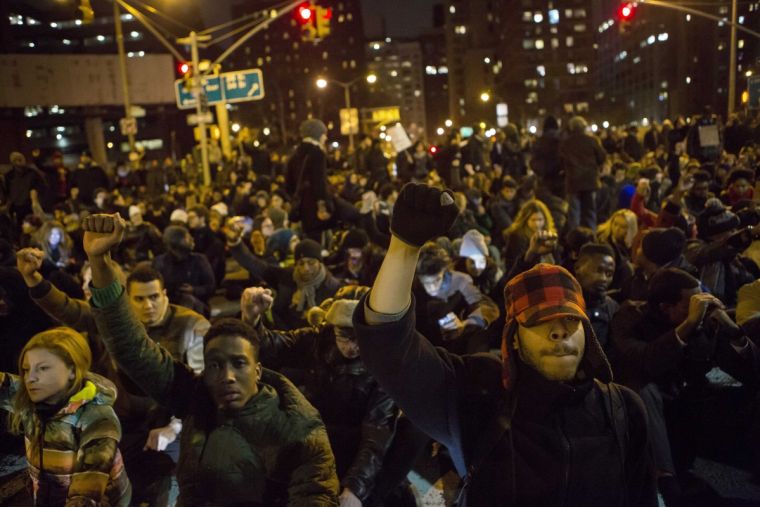'Black lives and brown lives matter as much as white lives.' New York Mayor speaks as Eric Garner protests continue

Protesters swarmed streets of Manhattan and other cities for a second night of mostly peaceful rallies to denounce a New York grand jury's decision to spare a white police officer from criminal prosecution in the choking death of an unarmed black man.
The reaction to Wednesday's decision not to indict officer Daniel Pantaleo for his role in the videotaped confrontation that left 43-year-old Eric Garner dead echoed a wave of outrage sparked nine days earlier by a similar outcome in the fatal shooting of an unarmed black teenager by a white policeman in Ferguson, Missouri.
US Attorney General Eric Holder, who already has mounted a civil rights review of the Ferguson shooting, on Thursday promised a full probe of the New York case.
Pantaleo could still face disciplinary action from an internal police investigation, his lawyer said, adding that he expects that process to move quickly and that his client would be exonerated.
A departmental investigation will likely focus on whether Pantaleo employed a chokehold, banned by police department regulations, in restraining Garner as he and other officers sought to arrest him for allegedly selling cigarettes illegally on a Staten Island sidewalk in July.
In addition to triggering protests around the country, the New York and Missouri cases have re-ignited debate over a US law enforcement system widely perceived to unfairly target African Americans and other minorities.
SECOND NIGHT OF PROTESTS
Thousands of marchers snaked through the streets of Manhattan on Thursday night, beginning at the evening rush hour and picking up recruits along the way, often weaving between cars and trucks and bringing traffic to a near standstill.
Tensions rose as a crowd of at least 3,000 congregated in Times Square about an hour before midnight, shouting at police, "Who do you protect?" as hundreds more officers moved in to force protesters onto sidewalks. There were a number of arrests but no overt outbursts of violence.
Hours earlier, protesters parading through lower Manhattan staged sporadic sit-ins at intersections before police in riot gear warned them to move on or face arrest. Most marchers complied, and the atmosphere among the racially mixed crowd was boisterous, upbeat and mostly peaceful.
Sharon Gordon, 52, of Matawan, New Jersey, said she hoped politicians would take heed. "There's been a confluence of social media and outrage," she said. "I do believe for the first time we're about to make a change."
Subsequent waves of marchers later crossed two bridges connecting Manhattan and Brooklyn, briefly blocking traffic, then converged on Manhattan's southern tip, at the ferry terminal for Staten Island.
The main group of demonstrators headed west and briefly closed the West Side Highway, resulting in at least a handful of arrests, before turning north again through Greenwich Village and Chelsea.
A smaller crowd confronted police with taunts. Chesray Dolpha, 31, yelled at the officers: "We are not violent. We are not touching you. What are you doing with that baton, brother?" The police made eye contact but did not reply.
Thursday's rallies in New York and elsewhere were generally larger and more numerous than the previous night.
Hundreds took to the streets of the nation's capital, chanting, "No justice, no peace, no racist police," as they passed the Justice Department, neared the White House and headed on to the Washington Monument. Protesters staged a "die-in" there, sprawling on the roadway to block traffic.
In Minneapolis, dozens of protesters blocked traffic on Interstate 35W, at times marching or lying down in the middle of the highway, escorted by police seeking to keep demonstrators moving.
Protesters in Chicago disrupted traffic on Lake Shore Drive, and a crowd of demonstrators, reported by the Boston Globe to have numbered in the thousands, gathered at the annual holiday tree-lighting ceremony on the Boston Common.
On the West Coast, a subway station was closed in Oakland, California, due to a "civil disturbance" there, transit officials said, while a "die-in" across the bay forced authorities to reroute traffic around a portion of San Francisco's famed Market Street.
CHOKEHOLDS AND RETRAINING
Unlike the August 9 fatal shooting of 18-year-old Michael Brown by a policeman under disputed circumstances in the St. Louissuburb of Ferguson, Missouri, Garner's encounter with New York police was captured on video that went viral online.
The clip from a bystander's mobile phone shows Pantaleo grabbing Garner from behind with his arm wrapped around Garner's throat, wrestling him to the sidewalk as three other officers helped subdue him. Garner is heard repeatedly gasping, "I can't breathe" - a phrase protesters have taken up a rallying cry.
Pantaleo's lawyer, Stuart London, said on Thursday his client testified to the New York grand jury that he never put pressure on Garner's neck but instead used a proper takedown technique.
The city's medical examiner has said officers killed Garner by compressing his neck and chest, adding that Garner's asthma and obesity contributed to his death.
Although chokeholds are officially prohibited, the 2,000-page police patrol guide is vague about whether they are permitted under certain circumstances, said Maria Haberfeld, who heads the law and criminal justice department at John Jay College.
That grey area, she said, may have influenced the grand jury and could be a factor in the departmental probe.
New York City Mayor Bill de Blasio, who took office in January promising to improve police relations with minorities, told reporters the city's thousands of officers would undergo extensive retraining.
"The relationship between police and community has to change," he told a news conference. "People need to know that black lives and brown lives matter as much as white lives."











